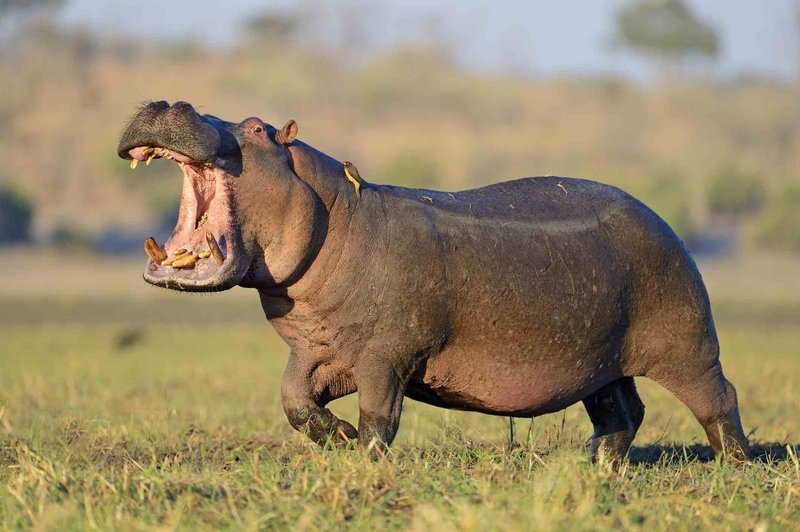
Imagine sitting by a waterhole in Africa, and you spot a hippo barely breaking the surface while keeping a watchful eye on its surroundings. These creatures may look slow and clumsy, but they’re surprisingly agile. They spend most of their day submerged in water to keep cool, but when it comes to their home turf, they can move faster than you might think. So, pour yourself a cup of coffee, and let’s explore the top ten facts that will make you see hippos in a whole new light.
1. Hippos Are Surprisingly Heavyweight Champions
Hippos are the third-largest land mammals, right after elephants and white rhinos. An adult hippo can weigh anywhere from 3,000 to 4,000 pounds. That’s like having a car parked in your backyard! But don’t let their size fool you; beneath all that bulk lies a surprisingly agile creature. Hippos can run 19 miles per hour on land, which is faster than most humans can sprint!
Their massive bodies are adapted to their semi-aquatic lifestyle. With short legs and a barrel-shaped body, they are built to walk along riverbeds and move through water, which helps support their weight. Here’s the thing: even though they spend most of their time in water, they can’t actually swim. Instead, they walk along the river or lake bed, which is a pretty cool way to stay cool in the heat of the day.
2. A Hippo’s Mouth is a Sight to Behold
When a hippo opens its mouth, it’s more than just an invitation to take a look; it’s a demonstration of strength and size. A hippo’s mouth can open up to 150 degrees, showcasing its enormous teeth that can grow up to 2 feet long! These teeth aren’t for eating meat, though. Hippos are herbivores, munching on grass and leaves mostly at night. Their impressive jaws are primarily used for fighting and establishing dominance among other hippos.
They may seem like peaceful grazers, but hippos are incredibly territorial—especially when it comes to their space in the water. If another animal (or even a human) gets too close, those mighty jaws can be lethal. So, while they might look adorable lounging in the sun, it’s wise to keep a respectful distance!
3. They Have a Unique Way of Communicating
Hippos are quite vocal creatures, and they have an array of sounds to convey their feelings. They can make a series of grunts, wheezes, and even honks to communicate with each other. This underwater language is fascinating; hippos can make sounds while submerged using a special technique that involves their vocal cords.
But here’s the thing: they can also communicate by exhaling air through their nostrils, creating a rhythmic puffing sound. If you ever find yourself near a group of hippos, pay attention to their sounds. You might witness a lively discussion unfolding beneath the surface!
4. They’re More Than Just Water Dwellers
Though hippos spend a lot of time in water, they actually need to come ashore regularly to graze. Hippos can roam up to 10 miles in search of food at night and typically eat around 80 pounds of grass. That’s a lot of munching!
Their diet is a bit like a midnight snack that never ends. Despite their size, they eat in a pretty efficient manner, ripping grass with their strong teeth and chomping it down. As they graze, they also play a vital role in their ecosystem by controlling grass growth and providing pathways for other animals. It’s like being a healthy lawnmower while having a party in the process!
5. Hippos Are Surprisingly Fast Swimmers
While hippos don’t swim in the traditional sense, they can cover a lot of ground in the water with surprising speed. You might think of them as lumbering giants, but when they’re gliding through rivers and lakes, they can reach speeds of up to 8 kilometers per hour (about 5 miles per hour).
Their adaptations allow them to move with ease; they can hold their breath for about five minutes while submerged. This makes them agile predators, in a way, as they can sneak up on their prey and emerge unexpectedly. Hippos are more than just the laid-back water sliders they seem to be!
6. Their Skin is Unique and Protective
Hippos have thick, hairless skin that’s surprisingly sensitive, accounting for about 2 inches of thickness in some areas. This skin has natural oils that keep it moisturized and protected from sunburn. In fact, hippos secrete a reddish fluid known as “blood sweat,” which is a natural sunscreen and antimicrobial agent.
This liquid helps protect their skin from the harsh sun while also acting as a form of hydration. It’s almost like having built-in sunscreen! So, while they might appear like armored tanks, hippos have their own way of taking care of themselves in the sun-soaked African landscape.
7. A Social Animal at Heart
Hippos are highly social creatures that thrive in groups called pods or schools. These groups typically consist of around 10 to 30 members, but populations can grow into the hundreds in certain areas. Social interactions are crucial for maintaining relationships and hierarchy within the group.
The females usually lead these pods, showcasing a strong matriarchal structure. Males, while dominant and protective, often engage in displays of strength to assert their position. Watching a pod of hippos interact is like watching a large family with their own dynamics, complete with playful nudging and quarrels over space.
8. Hippos Have a Unique Sleeping Style
Ever wonder how hippos sleep with all that water around? It might surprise you to learn that they can actually sleep underwater! They have a reflex that allows them to surface for air without waking up. This means they can doze while still keeping their heads above the water without even thinking about it!
When they sleep on land, they tend to arrange themselves in a circle, with some hippos keeping watch while others rest. It’s a clever way to stay safe from potential threats. Answering the call of nature is no picnic either—they often release waste while submerged, helping to fertilize the water plants around them. Talk about multitasking!
9. They Face Several Threats
Unfortunately, hippos are not without their challenges. Their populations are threatened by habitat loss, hunting, and illegal poaching for their ivory teeth. Conservationists are working hard to raise awareness about their plight and protect their habitats.
Despite their size and strength, hippos can’t fend off poachers alone. It’s crucial to support initiatives aimed at preserving their environments and promoting coexistence with local communities. We need to ensure these fascinating creatures continue to thrive for generations to come.
10. Hippos Have a Place in Culture and Folklore
Finally, hippos have made their mark not just in nature but in culture as well. They’ve popped up in folklore, art, and even popular media. From being the centerpiece in ancient Egyptian mythology to appearing in animated films, hippos have captured our imagination.
These charming giants symbolize strength, resilience, and community. Whether they’re gliding gracefully through the waters or causing a bit of mischief, hippos hold a unique place in the hearts of many around the world.
In conclusion, hippos are much more than just oversized animals lounging by the water. They are fascinating creatures with unique behaviors and characteristics that make them a vital part of their ecosystem. The next time you think about hippos, remember the incredible facts we’ve discussed here, and maybe you’ll appreciate them a little more. They’re not just fascinating animals; they’re a crucial piece of our natural world.

